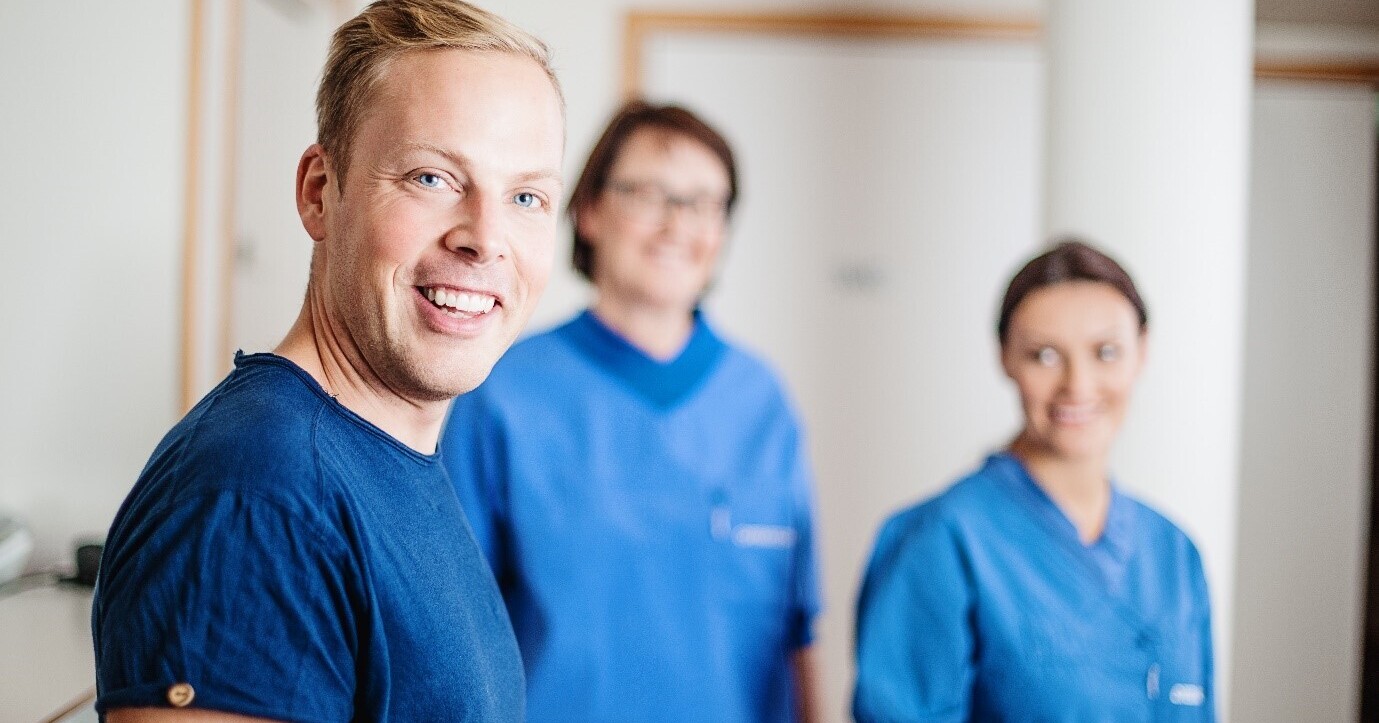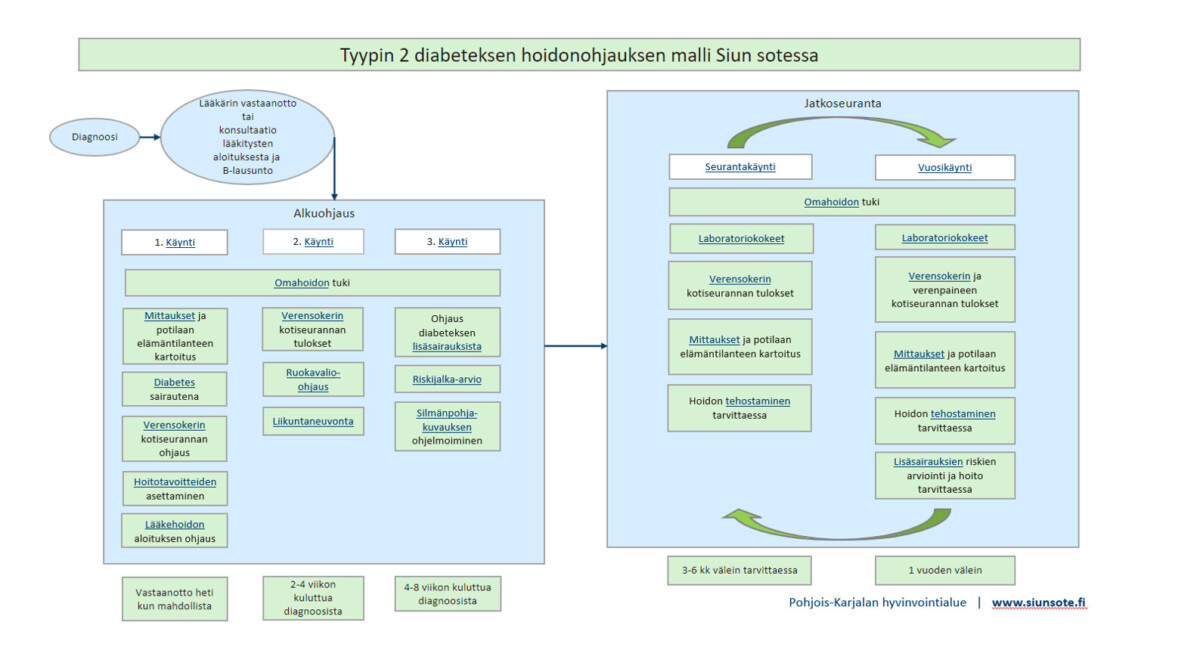
Savonia Article: Developing diabetes care
Diabetes is a worldwide growing problem in health care. At North Karelia wellbeing services county (Siun sote) we have about 16 000 people with diabetes. The national health index shows that North Karelian patients (along Northern Savonia) are the most multimorbid in Finland. We also suffer from lack of doctors. There is a 35,3 % deficit of doctors in North Karelia. This all together sets an enormous pressure for the nurse’s expertise on diabetes care.
The objective of treating type 2 diabetes is to prevent acute and long-term complications conducted by diabetes and support people with diabetes on their self-management. The purpose of the diabetes self-management education is to secure patient appropriate knowledge and ability to treat diabetes. How can this be done?
In my work as a diabetes nurse, I have seen the change in nursing and also witnessed co-workers leaving the health care. New colleagues have been enthusiastic to start working in primary care, however not so excited of treating people with diabetes. Why is it so? -Maybe because diabetes care demands deeper knowledge and experience of treating diabetes and also comprehension of how to support patient with long-term illness. Patients have often other long-term illnesses such as cardio diseases, high blood pressure, sleep apnea and overweight. The deficiency in knowledge and work experience may decrease nurse´s interest in treating people with diabetes.
At spring 2023 a group of Siun sote diabetes professionals started creating the regional type 2 diabetes treatment program. It was experienced that a model of type 2 diabetes self-management education would benefit our nursing staff and eventually also our patients. At conversations between colleagues at Siun sote Diabetes center and other nurse at primary care and my own health center, we recognized that every municipal and even nurse have their own way of treating people with diabetes. It was recognized that if we want to give our patients equal, high-quality care in every corner of North Karelia wellbeing services county, there has to be some kind of model of how to treat our patients. In Finland the Type 2 diabetes Käypä hoito -recommendation guides the treatment of diabetes. Nevertheless, we found it necessary to create our own model beside.
The model of type 2 diabetes self-management education (picture 1) was created as a development assignment in my studies of advanced nurse practitioner at Savonia UAS. The model was addressed to nursing staff who guide and support people with diabetes on primary care. The model of type 2 diabetes self-management education was produced as a part of Siun sote type 2 diabetes regional treatment program. The objective of the model was to standardize the care of people with type 2 diabetes on North Karelia wellbeing services county.

Picture 1. Model of type 2 diabetes self-management education in North Karelia wellbeing services
In this development assignment I created a model of type 2 diabetes self-management education. This model includes the content of guidance for recently diagnosed patient, continuing monitoring visits and yearly appointments. The methods of supporting self-management and multidisciplinary care are also declared. The created model is premised on evidence-based knowledge, research results, multidisciplinary discussion and the experience of professionals working at Siun sote Diabetes center.
In the model the guidance for recently diagnosed patient is divided in 3 appointments. These appointments should come true in process of 2 months from the diagnosis. The first appointment includes patient measurement (such as weight and blood pressure), blood glucose measuring guidance and medication guidance. On the first appointment the goals of patient´s diabetes care should also be determined with the patient. The second appointment consists of diet education. On this appointment it is beneficial to discuss also about exercise and it´s effects on blood glucose. The patient can be guided to physiotherapist for exercise counseling. On the third appointment diabetes complications and continuation of the care are discussed. The patient´s feet should be examined, and the retinopathy screening planned.
After the proper education in the start, the patient has the knowledge and ability to self-management. It is crucial to invest on the education in the start and the patient´s ability to achieve information and his/her own goals should be taken account when planning the care and appointments.
The need for follow-up visits depends on the balance of the sugar levels and the patient´s need for support in self-management. Yearly visits are necessary to detect the symptoms or laboratory results that indicate of diabetes complications. The yearly visit is an excellent opportunity to examine the patient´s overall situation. Often there are many things that affect on the self-management of diabetes. These are for example the financial situation and unemployment, family status and perhaps mental issues. Patient should be faced in a comprehensive way.
The main point in treating people with diabetes is the self-management support. It is obvious that recently diagnosed patients have a strong need for knowledge of their disease in the beginning, but the continuing support should be present in every contact. Patients need the feeling of capability and hope. The self-management education should be patient-centered and positive input is important. The diabetes nurse’s role is to stand beside, support and courage the patient, but also accept the choices patient makes on treating him/herself, although these choices may not always be the best for the patient´s health.
How can we benefit from evidence-based knowledge in diabetes care? First of all we should have the interest of searching new research results and recommendations. Then we should be able to question the manners that we have been using and adopt new ways of working. Creating the type 2 diabetes self-management education model arouse the interested in finding out what can and should be done differently. How could I do better?
The model of type 2 diabetes self-management education can be used as an introduction to nursing staff on how to treat people with type 2 diabetes. As an output of development assignment, the model was published at Siun sote website as a part of the regional type 2 diabetes treatment program.
Writer:
Hanna-Maria Rummukainen, Advanced Nurse Practitioner -student from Savonia UAS
References:
Ilanne-Parikka, Pirjo, Niskanen, Leo, Rönnemaa, Tapani, Saha, Marja-Terttu 2019. Diabetes. Kustannus Oy Duodecim.
Lääkäriliitto 2022. Terveyskeskusten lääkäritilanne 2022. Saastamoinen Peppiina. https://www.laakariliitto.fi/site/assets/files/5223/2022_terveyskeskusten_laakaritilanne_final3.pdf.
Terveyden- ja hyvinvoinnin laitos 2023. Kansallinen terveysindeksi. Hyvinvointialueiden tiedot vuosilta 2019–2021. Koponen, Päivikki, Lindell, Elsi, Sarnola, Kati, Luoto, Riitta. Verkkojulkaisu.https://thl.fi/documents/10531/10548970/Kansallinen+terveysindeksi_julkaisu_31_05_2023_korj.pdf/ec0582bd-0ce9-984d-ebad-593a8392614e?t=1686552716379.
Tyypin 2 diabetes. Käypä hoito -suositus. Suomalaisen Lääkäriseuran Duodecimin, Suomen Sisätautilääkärien yhdistyksen ja Diabetesliiton Lääkärineuvoston asettama työryhmä. Helsinki: Suomalainen Lääkäriseura Duodecim, 2020. https://www.kaypahoito.fi/hoi50056#s11.